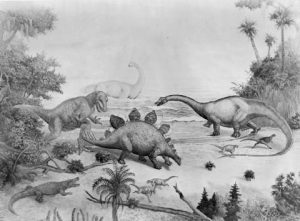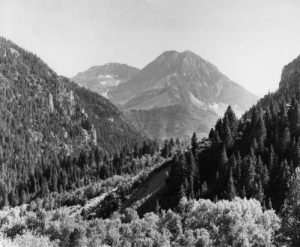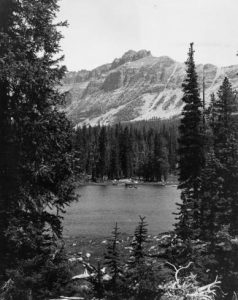Make the Uintah Basin Great Again

Prehistoric reptile and plant life of the Uinta Basin is shown in this picture of Ernest Untermann's. Solidified basic of brontosaurus and many other prehistoric creatures have been removed from the shales and sandstones of this monument (Dinosaur Nat. Mon.) in Utah.
Craig Fuller, Utah History Encyclopedia, 1994
The Uinta Bowl and Mountains are located in the northeast corner of the state and are part of a larger physiographic surface area known equally the Colorado Plateau Province. The Uinta Mountains, a folded and faulted anticlinorium (a succession of geological anticlines and synclines), are 150 miles long and are oriented in an east-west direction; they extend from Heber Valley on the west to Cross Mountain in Colorado to the east. The mountain range is thirty miles wide. The Uintas contain some of the highest mountain peaks in the state, Kings Elevation being the highest at thirteen,520 feet. The mountains receive annually virtually thirty inches of precipitation. During the Pleistocene era the Uintas were extensively glaciated. Lakes formed by this procedure boss the mountains. Some of the larger lakes today serve as important reservoirs for the Wasatch Front end.
In add-on to the Swell Salt Lake, the Uinta Mountains are perhaps the most important physiographic feature in northern Utah and the central Intermountain region. The Uintas are primal to the historic and economic developments of northern Utah. They are the source for several of the virtually important Wasatch Front rivers and streams including the Behave, the Weber, and the Provo. They are also an of import source of h2o for Green River, a major tributary to the Colorado River. The Uintas contain Ashley and Wasatch National Forests as well as the High Uinta Archaic Area.

Uinta Mountains
The Uinta Basin lies southward of the Uinta Mountains. The southern rim of the basin is formed by the Tavaputs Plateau of the Book Cliffs, and the western rim is formed by the Wasatch Mountains. The primal portion of the bowl has an elevation of 5,000 to 5,500 feet. Cobblestone Ridge divides the Utah portion of the Basin into two unequal parts. Between Asphalt Ridge and the Utah-Colorado state line is Ashley Valley, named for William H. Ashley, an important fur-trapping and trading entrepreneur of the 1820s.
The average almanac atmospheric precipitation for the Uinta Basin is less than viii.v inches, with a smaller surface area around Ouray and Leota receiving less than vi inches annually. Nevertheless, the bowl is well watered. The Strawberry River drains the eastern slope of the Wasatch Mountains. The south flank of the Uintas is drained by Current Creek, the Duchesne River, Lake Creek, the Uinta River, Ashley Creek, and Large and Little Brush creeks. The southern portion of the Basin contains fewer streams and they are much smaller in book than those of the northern portion. Dark-green River slices through the Uintas at Split Mount and flows through the Uinta Bowl in a southwesterly direction. At Ouray the Dark-green is joined by the Duchesne River, and White River which flows from the east.
Based on the modified Kopper system for identifying climatic zones, the Uintas, the Wasatch Mountains, and the southwest portion of the Book Cliffs are classified as undifferentiated highlands and the Uinta Basin as steppe. The Basin averages betwixt 80 and 160 frost-free days a year while much of the Uintas has less than 40 days gratis of frost.
The Uinta Basin and Mountains possess an affluence of prehistoric remnants. A curt distance north of Jensen on the Green River is a famous dinosaur quarry. This area was showtime discovered in 1909 past geologist Earl Douglas of the Carnegie Museum. During the adjacent several years Douglas and others excavated and hauled to eastern museums tons of dinosaur fossils from the Morrison Formation of the Upper Jurassic Age. In 1915 President Woodrow Wilson set aside 80 acres every bit a national monument. Intensive study and work continues at Dinosaur National Monument, nine miles north of Jensen, and thousands of visitors tour the monument each yr.

Uinta Mountains, Mirror Lake
At to the lowest degree two Paleo-Indian cultural sites (12,000-viii,500 before present) have been located in the Uinta Basin. These people were primarily hunters of the mammoth, bison, and other big game. During the Archaic period (8,500-2,500 B.P.), the bowl was occupied by Plateau Archaic People, people were gatherers as well as hunters. More recently, people identified with the Fremont Civilization have occupied the Uinta Basin. The Fremont Civilization parallels in time and development the better known Anasazi Culture. People of the Fremont Culture lived in semi-subterranean shelters (kivas) and were dependent primarily upon corn agriculture and hunting of smaller game and angling.
During the ethnohistorical period (A.D. 1300 to present), the Uinta Basin has been occupied past the Uinta-ats (Uinta), a ring of Utes. The bowl was too occasionally visited past the Northern and Northwestern Shoshones. The basin at once was a rich provider of food and clothing for the Ute Indians.
The first white men to set up eyes on the Uinta Bowl and Uinta Mountains were members of the minor Spanish expedition from Santa Fe headed past Fray Silvestre Velez de Escalante and Fray Francisco Atanasio Dominguez. The trek crossed into Utah and the Uinta Basin several miles northeast of present day Jensen. These intrepid explorers opened the Uinta Basin and the eastern portion of the Smashing Basin to Spanish, and later Mexican, American, and British fur-trappers and traders. Between the late 1820s and the 1840s the basin and mountains were visited by such men every bit William H. Ashley, Etienne Provost, Antoine Robidoux, and Kit Carson. At to the lowest degree two semipermanent trading posts were established in the bowl: Fort Robidoux, sometimes referred to as Fort Uintah or Winty (1830s–44) and Fort Kit Carson (1833–34). Several important U. S. government expeditions visited the area, including Helm John C. Fremont trek in the 1840s, and Major John Wesley Powell who floated downward the Greenish River from Green River, Wyoming in 1869 and again in 1871.
The Uinta Basin drew little interest during the initial phase of settlement of the Great Basin. Early on in the 1860s Brigham Young did lodge a pocket-sized trek to the Uinta Basin to determine the suitability for locating settlements there. Upon the expedition'south return, the Deseret News reported that the expedition had found little there and that the basin was a "vast contiguity of waste . . . valueless excepting for nomadic purposes, hunting grounds for Indians and to hold the globe together."
Presently after, well-nigh of the Uinta Basin was set up bated by Presidential proclamation for an Indian reservation. It was not until the late 1860s, even so, that most of the Utes residing in Utah Valley and areas south were relocated to the new Indian reservation. A second temporary Indian reservation, located due south of present day Ouray, was established in 1882 following the Meeker incident in western Colorado in 1879. The two reservations encompassed over 3.five million acres, much of which is semi-arid. Today the Uintah Utes, White River Utes, and Uncompahgre Utes occupy only a small fraction of their former reservation lands; nevertheless, the courts take granted to the Utes greater legal jurisdiction over the land which were one time the original Indian reservations.
Dissimilar other settlements in Utah, Ashley Valley was not "called" past Mormon leaders to be settled. Outset in the early on 1870s, Mormon ranchers and other whites from the Indian Reservation began filtering into Ashley Valley, which first served as excellent summer feeding grounds for herds of cattle. Past 1880 in that location was a permanent population sufficiently large enough for Uintah County to exist established past the territorial legislature.
Inside a decade Gilsonite and other asphaltum minerals were discovered in Uintah Canton too as on the eastern edges of both Indian reservations. National and local pressure presently mounted to accept the ii Indian Reservations opened to white development. Even so, it was not until the passage of the Dawes Act of 1887 that federal means were established to have both Uinta Basin Indian reservations opened. Past 1898, following an effective campaign by national and local mining interests, the Uncompahgre Indian Reservation was thrown open up to miners and settlers. The Uintah Reservation followed in the summertime of 1905, after allotments of 160 acres were made to each adult male married Indian (lesser amounts were allotted to single males, single women and orphaned Indian children). In Baronial of 1905 thousands of potential homesteaders rushed to Grand Junction, Colorado, and to Vernal, Price, and Provo, Utah, to register for the land drawing which was held at the end of the month in Provo. Merely a fraction of registrants actually took up homesteads and many of those eventually gave upwardly on their efforts to secure inexpensive farmland. A sizable portion of Strawberry Valley was reserved for reclamation purposes. Boosted lands were added to Ashley and Wasatch National Forests. And some lands located along the foothills of the south flank of the Uintas were reserved for Indian grazing grounds.
The Uinta Bowl has been susceptible to frequent economic smash-bust cycles. For the almost part these have been continued with the discovery or development of various natural resource coupled with national and international economic weather. The first of these cycles was the rush for fur-bearing animals in the 1820s to 1840s. This was followed by the discovery of Gilsonite and other asphaltums. A railroad line was planned simply never fully materialized. The third boom-bust cycle was the opening of the ii reservations which increased the white population sufficiently that Duchesne Canton was carved out of Wasatch County. Commercial oil product was begun 1948 but was non fully exploited until the 1970s which increased the toll of crude oil. This in turn spurred private and public ventures to develop an inexpensive process for separating oil from oil shale and tar sands. Shortage of housing, increased school enrollments, and a vigorous economic activity was experienced in the 1970s because of this oil action. However, in 1980 international oil prices began to autumn. Correspondingly the economical health of the Uinta Bowl fell sharply. The evolution of h2o resource for the Wasatch Front has been all the same some other economic stimulus but this, besides, has been simply temporary.
See: One thousand. E. and Billie R. Untermann Guide to Dinosaur Land and the Unique Uinta Country (1972); W. R. Hansen, The Geologic Story of the Uinta Mountains (1969); J. Due west. Powell The Exploration of the Colorado River and Its Canyons (1961); David Lavender Colorado River Country (1982); Charles Kelley, editor, "Periodical of W. C. Powell," Utah Historical Quarterly (1948–49); Dale L. Morgan "The Exploration of the Colorado River in 1869," Utah Historical Quarterly (1947); Tamarack: Stories of the Uintah Basin (1976); and Grand. E. Untermann, Geology of Dinosaur National Monument and Vicinity, Utah-Colorado (1954).

Utah Topographical Map
Source: https://historytogo.utah.gov/uinta-basin/
0 Response to "Make the Uintah Basin Great Again"
Post a Comment